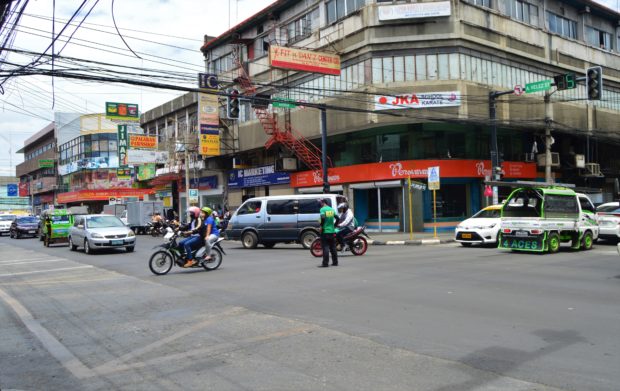
NO GRIDLOCK Traffic is light at a usually busy section of the city center of Cagayan de Oro as residents choose to stay home due to quarantine restrictions and the rising cases of COVID-19 in the regional capital of Northern Mindanao. —JIGGER J. JERUSALEM
DAVAO CITY, Davao del Sur, Philippines — The coronavirus pandemic has tempered the spending appetite of two large Mindanao cities in anticipation of revenue shortfalls.
The economies of Davao and Cagayan de Oro cities have started to pick up again after their quarantine classifications have been downgraded to modified general community quarantine, the status with the most relaxed restrictions, since Aug. 16.
As leaders in both cities opposed a return to strict lockdowns, they have pulled the brakes on further reopening of commerce amid the recent spike in new coronavirus disease (COVID-19) infections.
Amid this roller-coaster ride for businesses, they expect a dip in tax collections, prompting them to cut spending for 2021.
Davao Mayor Sara Duterte submitted a P9.8-billion annual budget for next year, P500 million less than the P10.3-billion approved spending for 2020. She earlier said the city would lose some P854 million in revenue this year due to the closure of many businesses.
As of September, the city government had collected P8.2 billion, of which P3.3 billion were local taxes. For 2020, the Department of Finance had set the city’s local collection at P5.95 billion.
The reduced spending for 2021, according to Duterte, will mainly affect the city’s drive for infrastructure improvements.
Davao City, which has a population of about 1.8 million, is Mindanao’s premier city and main economic hub.
In Cagayan de Oro, Mayor Oscar Moreno has endorsed a P7.25-billion budget for 2021, lower by P250 million than the approved 2020 spending of P7.5 billion. He cited “economic setbacks” that redound to lower tax collection for the proposed 2021 budget.
Economic setbacks
Moreno said next year’s budget also had a reordered focus in response to the challenges of the pandemic and restarting the city’s economy.
Of the P7.25-billion allotment, 41 percent would go to economic services and 32 percent to social services, including health, nutrition, hospital and welfare initiatives.
Infrastructure projects would continue as a way of generating employment, Moreno said.
He promised that no new taxes would be imposed to support the city government’s 2021 spending. The proposal, he said, contained measures to spruce up the local tax collection system, including the grant of incentives for early payments.
But the city would borrow P1 billion to bankroll major infrastructure initiatives. Among these are the redevelopment of a local government-run memorial park, with a P400-million allotment; completion of a five-story city library and school building with basement parking, P400 million; and completion of two hospitals in Lumbia and Tablon villages, P200 million.
Cagayan de Oro, which has a population of about 750,000, is the regional capital of Northern Mindanao. INQ